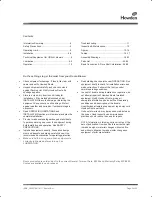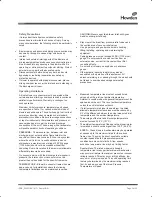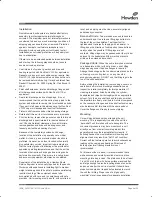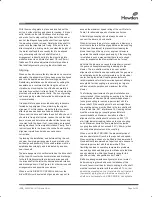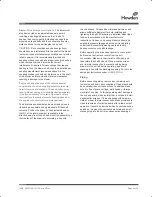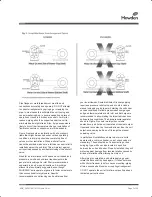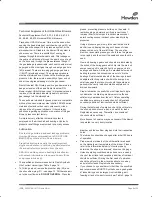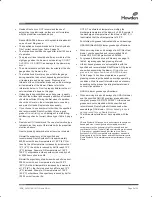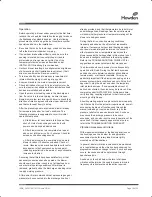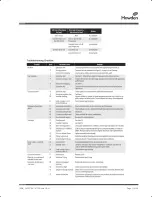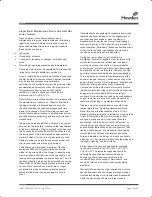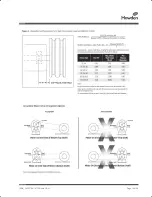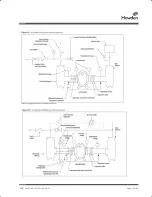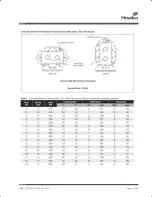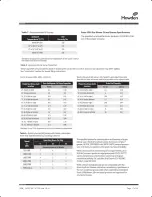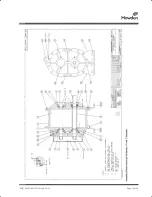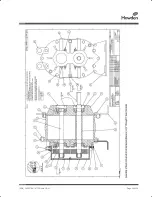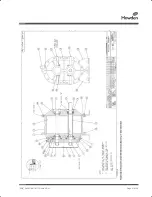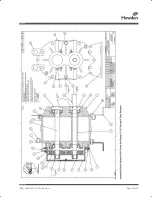
ISRB_2002 GEA 19171 Roots URAI
Page 8 of 32
Technical Supplement for URAI-G Gas Blowers
Technical Supplement for 32, 33, 36, 42, 45, 47, 53,
56, 59, 65, 68, 615 Universal RAI-G blowers
Precaution: URAI-G blowers: Care must be used when
opening the head plate seal vent chamber plugs (43) as
some gas will escape–if it is a pressure system, or the
atmospheric air will leak into the blower if the system is
under vacuum. There is a possibility of some gas
leakage through the mechanical seals. This leakage on
the gear end will escape through the gear box vent, and
on the drive end, through the grease release fittings. If
the gas leakage is undesirable, each seal chamber must
be purged with an inert gas through one purge gas hole
(43) per seal. There are two plugged purge gas holes
(1/8 NPT) provided per seal. The purge gas pressure
must be maintained one PSI above the discharge gas
pressure. Also, there exists a possibility of gear end oil
and drive end grease leakage into the gas stream.
Roots Universal RAI-G rotary positive gas blowers are a
design extension of the basic Roots Universal RAI
blower model. URAIG blower uses (4) mechanical seals
in place of the standard inboard lip seals to minimize
gas leakage into the atmosphere.
These units are intended for gases which are compatible
with cast iron case material, steel shafts, 300/400 series
stainless steel and carbon seal components, viton o-
rings and the oil/ grease lubricants. If there are any
questions regarding application or operation of this gas
blower, please contact factory.
A simple but very effective lubrication system is
employed on the drive shaft end bearings. Hydraulic
pressure relief fittings are provided to vent any excess
grease, preventing pressure build-up on the seals. A
restriction plug and metering orifice prevent loss of
lubricant from initial surges in lubricant pressure but
permit venting excess lubricant under steadily rising
pressures.
Using a pressure gun, slowly force new lubricant into
each drive end bearing housing until traces of clean
grease comes out of the relief fitting. The use of an
electric or pneumatic grease gun could force the grease
in too rapidly and thus invert the seals and should not be
used.
Gear end bearings, gears and oil seals are lubricated by
the action of the timing gears which dip into the main oil
sumps causing oil to splash directly on gears and into
bearings and seals. A drain port is provided below each
bearing to prevent an excessive amount of oil in the
bearings. Seals located inboard of the bearings in each
headplate effectively retain oil within the sumps. Any
small weepage that may occur should the seals wear
passes into a cavity in each vented headplate and is
drained downward.
Proper lubrication is usually the most important single
consideration in obtaining maximum service life and
satisfactory operation from the unit. Unless operating
conditions are severe, a weekly check of oil level and
necessary addition of lubricant should be sufficient.
During the first week of operation, check the oil levels in
the oil sumps about once a day, and watch for leaks.
Replenish as necessary. Thereafter, an occasional
check should be sufficient.
More frequent oil service may be necessary if the blower
is operated in a very dusty location.
Lubrication
Due to sludge build-up and seal leakage problems,
Howden Roots recommendation is DO NOT USE
Mobil SHC synthetic oils in Roots blowers.
Proper lubrication is usually the most important
single consideration in obtaining maximum service
life and satisfactory operation from the unit.
URAI Air and Gas gear end bearing lubrication/oil
with splash lubrication on the gear end only (Drive
end grease lubricated).
The specified and recommended oil is Roots Synthetic
Oil of correct viscosity per Table 2, page 16.
To fill the gearbox, remove the breather plug (25) and
the oil overflow plug (21) - see page 15. Fill the reservoir
up to the overflow hole.
DO NOT OVERFILL
. Place the
breather and the overflow plug back into their respective
holes.
The lubrication should be changed after initial 100 hours
of operation.
Proper service intervals of the oil thereafter are based
on the discharge air temperature of the blower. Please
refer to the information below to “How to properly
determine the oil service intervals” shown on this page.
Unless operating conditions are quite severe, a weekly
check of the oil level and necessary addition of lubricant
should be sufficient. During the first week of operation,
check the oil levels in the oil sumps about once a day,
and watch for leaks. Replenish as necessary.
If you choose to use another oil other than the specified
and recommended ROOTS Synthetic, use a good grade
of industrial type non-detergent, rust inhibiting, anti-
foaming oil and of correct viscosity per Table 2, page 16.
ISRB_2002 GEA 19171 Roots URAI.indd 8
17/09/2015 12:52
Summary of Contents for Roots Metric Series
Page 11: ...ISRB_2002 GEA 19171 Roots URAI Page 11 of 32...
Page 13: ...ISRB_2002 GEA 19171 Roots URAI Page 13 of 32...
Page 14: ...ISRB_2002 GEA 19171 Roots URAI Page 14 of 32...
Page 15: ...ISRB_2002 GEA 19171 Roots URAI Page 15 of 32...
Page 16: ...ISRB_2002 GEA 19171 Roots URAI Page 16 of 32...
Page 17: ...ISRB_2002 GEA 19171 Roots URAI Page 17 of 32...
Page 18: ...ISRB_2002 GEA 19171 Roots URAI Page 18 of 32...
Page 19: ...ISRB_2002 GEA 19171 Roots URAI Page 19 of 32...
Page 20: ...ISRB_2002 GEA 19171 Roots URAI Page 20 of 32...
Page 21: ...ISRB_2002 GEA 19171 Roots URAI Page 21 of 32...
Page 22: ...ISRB_2002 GEA 19171 Roots URAI Page 22 of 32...
Page 23: ...ISRB_2002 GEA 19171 Roots URAI Page 23 of 32...
Page 24: ...ISRB_2002 GEA 19171 Roots URAI Page 24 of 32...
Page 25: ...ISRB_2002 GEA 19171 Roots URAI Page 25 of 32...
Page 26: ...ISRB_2002 GEA 19171 Roots URAI Page 26 of 32...
Page 27: ...ISRB_2002 GEA 19171 Roots URAI Page 27 of 32...
Page 28: ...ISRB_2002 GEA 19171 Roots URAI Page 28 of 32...
Page 29: ...ISRB_2002 GEA 19171 Roots URAI Page 29 of 32...
Page 30: ...ISRB_2002 GEA 19171 Roots URAI Page 30 of 32...


